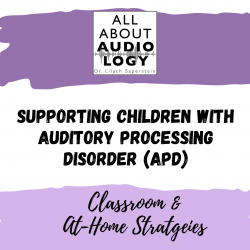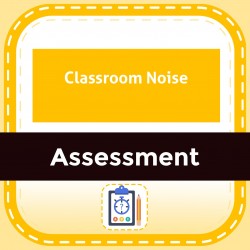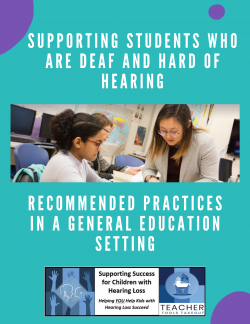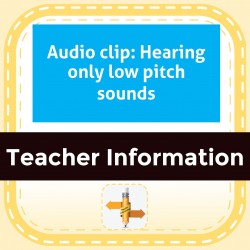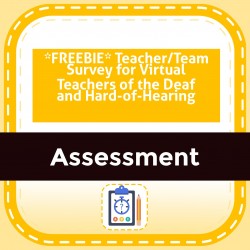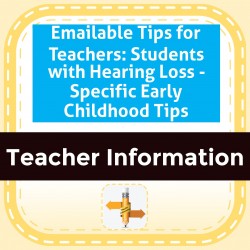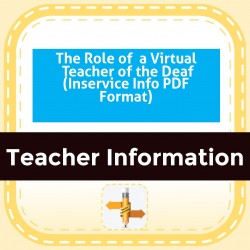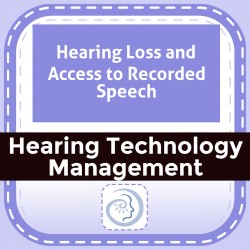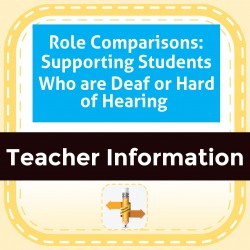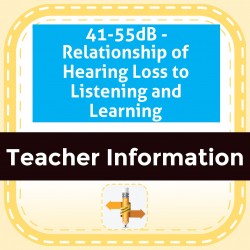Ability Levels
Categories
Resource Types
Age/Grade Range
CCSS
Anchor Standard
Speaking & Listening
Language
Reading
Supporting Children with Auditory Processing Disorder (APD): Classroom Strategies & At-Home Strategies
$ 199
A clear and simple list of strategies to support children with Auditory Processing Disorder (APD). For classroom and at-home use.
Classroom Noise Audio File
$ 0
This 10-minute audio file is a recording of classroom noise. It can be used as a part of assessment when testing listening ability for speech in noise. It can be used as a training tool for students w
...
orking to improve their speech-in-noise comprehension. It can be used as background noise while demonstrating the impact of hearing loss during inservice presentations to educators, school staff or parents. It is recommended that the professional with hearing loss upload the classroom noise file to their smart phone and other media devices to have it whenever a quick demonstration or listening challenge is needed.© SSCHL OWNED
Supporting Students who are Deaf and Hard of Hearing: Recommended Practices in a General Education Setting
$ 0
Tip sheet for related service providers with 5 main tiPS-. From Clerc Center Gallaudet.
Audio clip: Hearing only low pitch sounds
$ 150
Simulation from original 1960s record: low pitch hearing loss.
*FREEBIE* Teacher/Team Survey for Virtual Teachers of the Deaf and Hard-of-Hearing
$ 0
This resource contains survey questions that for virtual Teachers of the Deaf and Hard-of-Hearing to share with their students' team members. Teachers can add these questions to a virtual form or an e
...
mail in order to obtain feedback about virtual DHH services.
Emailable Tips for Teachers: Students with Hearing Loss - Specific Early Childhood Tips
$ 0
TiPS- to email to preschool and kindergarten teachers to improve understanding of the needs of the student with hearing loss. Getting one tip at a time has been an effective strategy for implementatio
...
n. Focusing on one strategy each week reduces anxiety and results in an improvement in best practice tECH-niques for their students with hearing loss. These early childhood tiPS- should be used in conjunction with the school-age tiPS-, also available through Teacher Tools Takeout.
The Role of a Virtual Teacher of the Deaf (Inservice Info PDF Format)
$ 5
This resource is a PDF version of the Powerpoint presentation discussed below for those who may prefer PDF. This resource is a Powerpoint presentation that outlines the role of a virtual Teacher of th
...
he Deaf/Hard-of-Hearing. The presentation describes the remote learning process, the role of the Teacher of the Deaf, and some benefits of remote learning. It can be used as an inservice tool or as an introduction to remote learning for school personnel who may not be familiar with working with a remote team member.
Hearing Loss and Access to Recorded Speech
$ 195
An increasing number of educational resources are being delivered through recorded speech in the younger grades, listening centers, and test examinations. This article focuses on the reasons why recor
...
ded speech are so challenging for students who are hard of hearing thus necessitating a live voice reader in many situations.
Role Comparisons: Supporting Students Who are Deaf or Hard of Hearing
$ 0
Handout designed to support discussion by school teams regarding the role of the teacher of the deaf/hard of hearing, educational audiologist, speECH- language pathologist, special educator, and sign
...
language interpreter in providing support and services to students with hearing loss. Includes possible issues that need to be considered specific to hearing loss.
43-55dB - Relationship of Hearing Loss to Listening and Learning
$ 0
Handout with information on possible impact on understanding language, speECH-, social, and need for educational accommodations and services. For 43-55dB or moderate hearing loss.
 Your browser is out of date. For best experience switch to latest updated Browser.
Your browser is out of date. For best experience switch to latest updated Browser.
 Get Chrome
Get Chrome Get Edge
Get Edge Get Firefox
Get Firefox